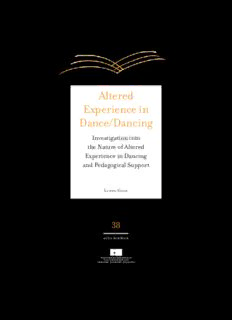
Altered Experience in Dance/Dancing PDF
Preview Altered Experience in Dance/Dancing
Altered Experience in Dance/Dancing Investigation into the Nature of Altered Experience in Dancing and Pedagogical Support Linda Gold 38 acta scenica Altered Experience in Dance/Dancing Investigation into the Nature of Altered Experience in Dancing and Pedagogical Support Linda Gold Altered Experience in Dance/Dancing - Investigation into the Nature of Altered Experience in Dancing and Pedagogical Support Doctoral dissertation Publisher Theatre Academy, Performing Arts Research Centre © Theatre Academy and Linda Gold Graphic design Hahmo Design Oy www.hahmo.fi Layout Edita Prima Oy Cover drawing Linda Gold Printed by Edita Prima Oy, Helsinki 2013 Paper Carta Integra 300 g / m2 & Cocoon offset 120 g / m2 Font family Filosofia. © Zuzana Licko. Acta Scenica 38 ISBN (paperback) 978-952-6670-19-5 ISBN (pdf): 978-952-6670-20-1 ISSN (paperback) 1238-5913 ISSN (pdf) 2242-6485 Table of Contents Acknowledgments 7 Abstract 9 Chapter 1: Researcher Stance, Prior Background, and Research Questions 11 Chapter 2: Literature Review 20 Chapter 3: Methodology and Dance Course Description 61 Chapter 4: Findings and Interpretations 106 Chapter 5: Conclusions and Recommendations 171 Bibliography 190 Appendices Appendix I 202 Appendix II 217 Dedication To my parents, who taught me by example to seek and value the truth, and to the remarkable teachers who have guided me on this path. Acknowledgments Many individuals and institutions were important to the realization of this disserta- tion. I gratefully acknowledge them all, and name those most notable to the project. I thank external examiner Associate Professor Susan Koff for her grasp of nu- anced concepts. Her guidance helped re-orient my writing and encouraged the de- velopment of new thoughts and directions. I thank external examiner Dr. Karen Bar- bour for her meticulous attention to detail and structure. Her suggestions helped me to reformulate this dissertation and make it more cohesive and expressive of the research. I thank advisor Professor Leena Rouhiainen for her sensitive insight and extensive knowledge, which she generously shared, and advisor Professor Emeritus Soili Hämäläinen for her unflagging support of my research process and her ability to find innovative solutions to whatever hurdles I encountered. Thanks also goes to Professor Esa Kirkkopelto for his vision and commitment to collegial research and for shepherding my work through administrative transi- tions, and to Annika Fredriksson, Research Coordinator, for her skillful manage- ment, and kindness in keeping me appraised of all logistical details and protocols. I want to thank the Theatre Academy, University of the Arts Helsinki, for the opportunity to undertake this research and explore a topic that I continue to find fascinating, and for providing the means to produce this research in its published form. I also want to acknowledge the faculty, librarians, and staff who I have had the benefit of working with. Their helpful knowledge and friendly assistance was always available. Thanks goes to Santa Monica College for the freedom in the classroom to develop and implement the teaching approach used in this investigation, and for the sabbat- icals that provided opportunities to expand my knowledge and initiate the writing of this dissertation. Further, I want to thank the students in the classroom investi- gation for their open and energetic participation. They were a pleasure to work with and I found their feedback stimulating and thought provoking. Great appreciation goes to Lynwood Lord for his careful copyediting of the written text, to John Samargis for his assistance in scanning graphic data and making it print ready, and to Tarja Lindroos for her expertise in the layout of this document. I want to thank my family and friends whose good counsel, good humor, and pa- tience throughout the many phases of this doctoral candidacy reinvigorated my ef- forts and kept me on track. And finally, I want to acknowledge the artists, scholars, teachers, and practitioners who encouraged my research and believed me a worthy exponent of the topic.
Description: